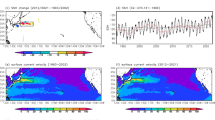Abstract
A relationship between paths of the Kuroshio and Kuroshio Extension (KE) is investigated, using the satellite-derived altimetry dataset of 1993–2008. When the Kuroshio takes the nearshore nonlarge meander path or typical large meander path and resultantly goes through the deeper channel (about 2500 m) of the Izu-Ogasawara Ridge, the KE path adopts a relatively stable state with the two quasi-stationary meanders. On the other hand, when the Kuroshio takes the offshore nonlarge meander path and then passes over the shallower part of the Ridge (about 1000 m), the KE path tends to be convoluted, i.e., an unstable state.






Similar content being viewed by others
References
Ducet N, Le Traon PY, Reverdin G (2000) Global high-resolution mapping of ocean circulation from TOPEX/Poseidon and ERS-1 and -2. J Geophys Res 105:19477–19498
Kawabe M (1995) Variations of current path, velocity, and volume transport of the Kuroshio in relation with the large meander. J Phys Oceanogr 25:3103–3117
Masuda A (1982) An interpretation of the bimodal character of the stable Kuroshio path. Deep Sea Res 29:471–484
Masuda A (1989) A laboratory experiment on the Kuroshio meander. Deep Sea Res 36:1067–1081
NGDC (2006) 2-minute gridded global relief data (ETOPO2). http://www.ngdc.noaa.gov/mgg/iers/01mgg04.html
Onogi K et al (2007) The JRA-25 reanalysis. J Meteor Soc Japan 85:369–432
Qiu B, Chen S (2005) Variability of the Kuroshio Extension jet, recirculation gyre, and mesoscale eddies on decadal timescales. J Phys Oceanogr 35:2090–2103
Qiu B, Chen S (2010) Eddy-mean flow interaction in the decadally modulating Kuroshio Extension system. Deep Sea Res 57:1098–1110
Rio MH, Hernandez F (2004) A mean dynamic topography computed over the world ocean from altimetry, in situ measurements, and a geoid model. J Geophys Res 109. doi:10.1029/2003JC002226
Rio MH, Schaeffer P, Lemoine JM, Hernandez F (2005) Estimation of the ocean mean dynamic topography through the combination of altimetric data, in-situ measurements and GRACE geoid: from global to regional studies. Proceedings of the GOCINA international workshop, Luxembourg
Stammer D (1997) Steric and wind-induced changes in TOPEX/POSEIDON large-scale sea surface topography observations. J Geophys Res 102:20987–21009
Sugimoto S, Hanawa K (2011) Roles of SST anomalies on the wintertime turbulent heat fluxes in the Kuroshio–Oyashio Confluence Region: influences of warm eddies detached from the Kuroshio Extension. J Clim. doi:10.1175/2011JCLI4023.1
Taguchi B, Xie SP, Schneider N, Nonaka M, Sasaki H, Sasai Y (2007) Decadal variability of the Kuroshio Extension: observations and an eddy-resolving model hindcast. J Clim 20:2357–2377
Acknowledgments
The authors wish to express their sincere thanks to the members of Physical Oceanography Group at Tohoku University for their useful discussion. Comments from three anonymous reviewers were particularly helpful for improving our manuscript. The first author (SS) was partly supported by the Sasakawa Scientific Research Grant from the Japan Science Society (No. 23–701) and by the Grant-in-Aid for Young Scientists (B) (No. 23740348) from the Japan Society for the Promotion of Science; by the Grant-in-Aid for Scientific Research on Innovative Areas (No. 23106501), “A ‘hot spot’ in the climate system: extra-tropical air-sea interaction under the East Asian monsoon system” from the Ministry of Education, Culture, Sports, Science and Technology. The second author (KH) was financially supported by the Japan Fisheries Agency.
Author information
Authors and Affiliations
Corresponding author
Rights and permissions
About this article
Cite this article
Sugimoto, S., Hanawa, K. Relationship between the path of the Kuroshio in the south of Japan and the path of the Kuroshio Extension in the east. J Oceanogr 68, 219–225 (2012). https://doi.org/10.1007/s10872-011-0089-1
Received:
Revised:
Accepted:
Published:
Issue Date:
DOI: https://doi.org/10.1007/s10872-011-0089-1




